The Complex Relationship Between Alcohol and Skin Health
Alcohol consumption is a common social activity, but its effects on the skin can be multifaceted. While many individuals experience visible skin reactions such as flushing and redness, these symptoms can range from mild and temporary to severe and indicative of underlying health issues. This article explores how alcohol use can cause or exacerbate various skin conditions, what symptoms to look for, and when medical attention is necessary.
What Does Alcohol-Damaged Skin Look Like?

What does alcohol-damaged skin look like?
Alcohol-related skin damage manifests in several noticeable ways. The skin often appears dry, flaky, and dull, losing its natural luster and elasticity. Regular alcohol consumption can lead to redness and flushing, especially on the face, as blood vessels dilate in response, sometimes resulting in persistent conditions like rosacea.
Over time, these blood vessel changes can cause visible, enlarged blood vessels known as telangiectasia, giving the skin a permanently reddened appearance. Skin infections, such as cellulitis, can also become more common in heavy drinkers, especially if the skin is wounded, due to immune suppression.
Long-term alcohol use is associated with jaundice—yellowish discoloration of the skin and eyes—indicating liver damage. Additionally, alcohol-induced dehydration contributes to puffiness around the eyes, dark circles, and a general appearance of tiredness.
Beyond facial changes, alcohol can cause hyperpigmentation or darkening of the skin, as well as increased sensitivity to sunlight, leading to burning and blistering.
In summary, alcohol damages skin by dehydrating tissues, impairing nutrient absorption, and aggravating skin conditions. The visible signs include dryness, redness, broken blood vessels, and signs of liver-related skin changes, all of which reflect the overall decline in skin health caused by alcohol.
Types of Skin Conditions Linked to Alcohol
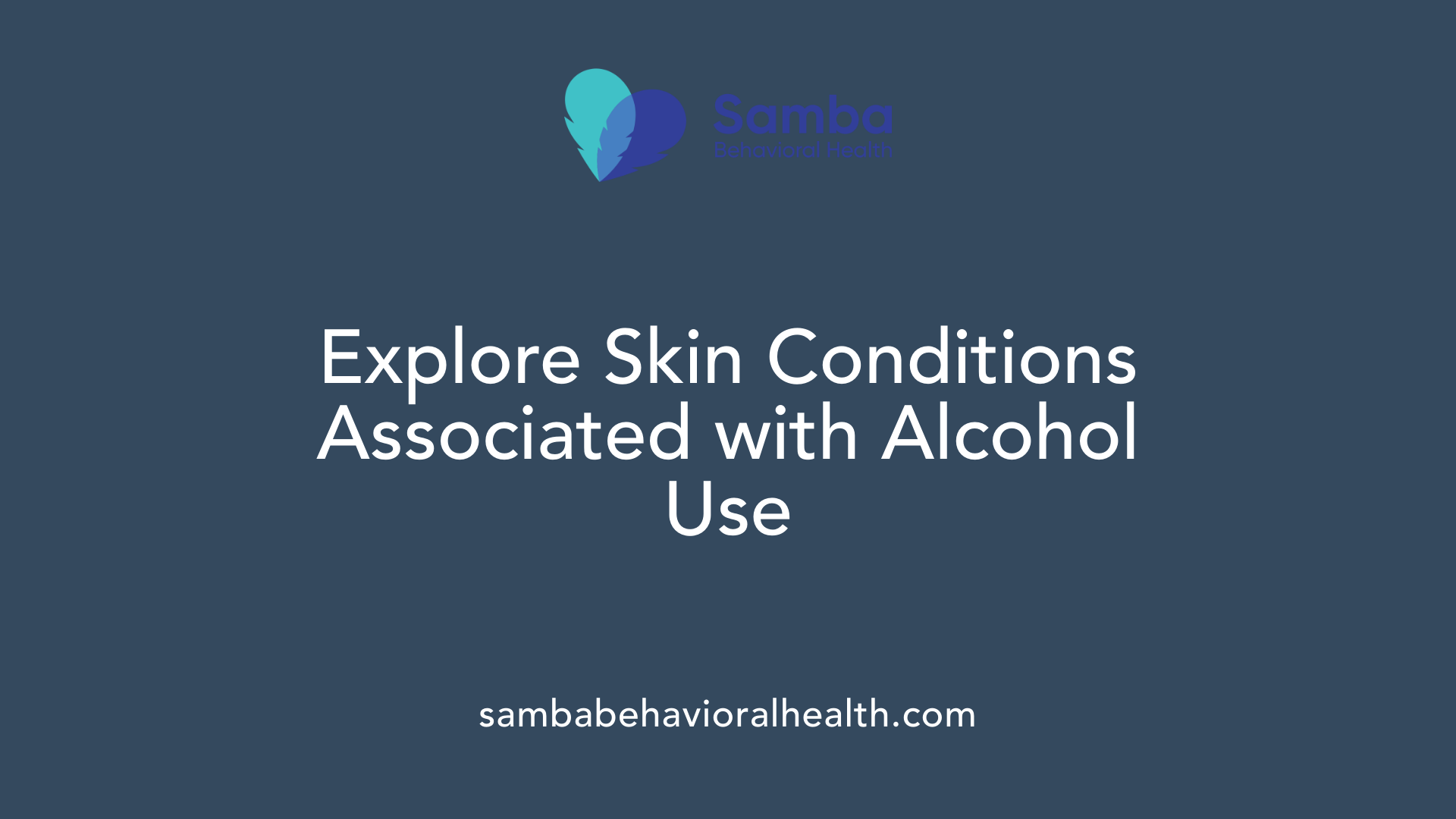
What types of skin conditions can be caused or worsened by alcohol consumption?
Alcohol consumption can influence various skin conditions, either triggering new issues or worsening existing ones. One common condition is alcoholic dermatitis, which appears as red, itchy, and inflamed patches primarily on the face and neck. These dermatitis episodes are due to alcohol's inflammatory effect on the skin, often accompanied by increased blood vessel dilation.
Another skin reaction frequently observed is the alcohol flush reaction. This condition is particularly common among individuals of East Asian descent and results in rapid redness and warmth of the face after drinking alcohol. It occurs because of the buildup of acetaldehyde, a toxic byproduct, due to genetic variations affecting alcohol metabolism.
Alcohol can also trigger urticaria or hives—itchy, raised welts that develop suddenly on the skin. These allergic-like responses are often due to hypersensitivity to alcohol itself or ingredients like preservatives and histamines present in certain drinks.
Furthermore, excessive alcohol intake can lead to nutritional deficiencies, notably vitamin C deficiency, known as scurvy. This deficiency weakens blood vessel walls, leading to fragile capillaries that cause petechial and ecchymotic rash, skin hemorrhages, and increased bleeding tendency.
In addition to these, alcohol exacerbates existing skin disorders such as rosacea, psoriasis, and eczema by increasing inflammation, promoting blood vessel dilation, and impairing skin repair.
Summary of alcohol-related skin conditions:
| Condition | Manifestation | Causes/Triggers | Additional Notes |
|---|---|---|---|
| Alcoholic dermatitis | Red, itchy patches | Inflammation from alcohol | Common on face/neck |
| Alcohol flush reaction | Facial redness, warmth | Acetaldehyde buildup | Genetic predisposition in Asians |
| Urticaria (hives) | Itchy, raised welts | Allergic/hypersensitivity | Triggered by alcohol ingredients |
| Vitamin C deficiency | Petechial and ecchymotic rash | Poor nutrition from alcohol use | Leads to fragile blood vessels |
| Rosacea | Facial redness, persistent flushing | Blood vessel dilation | Worsened by alcohol, |
underlying predisposition |
Understanding these conditions helps in managing symptoms and avoiding triggers. Consulting healthcare providers for proper diagnosis and tailored treatment is recommended to mitigate the skin impacts of alcohol.
Common Skin Reactions Associated with Alcohol
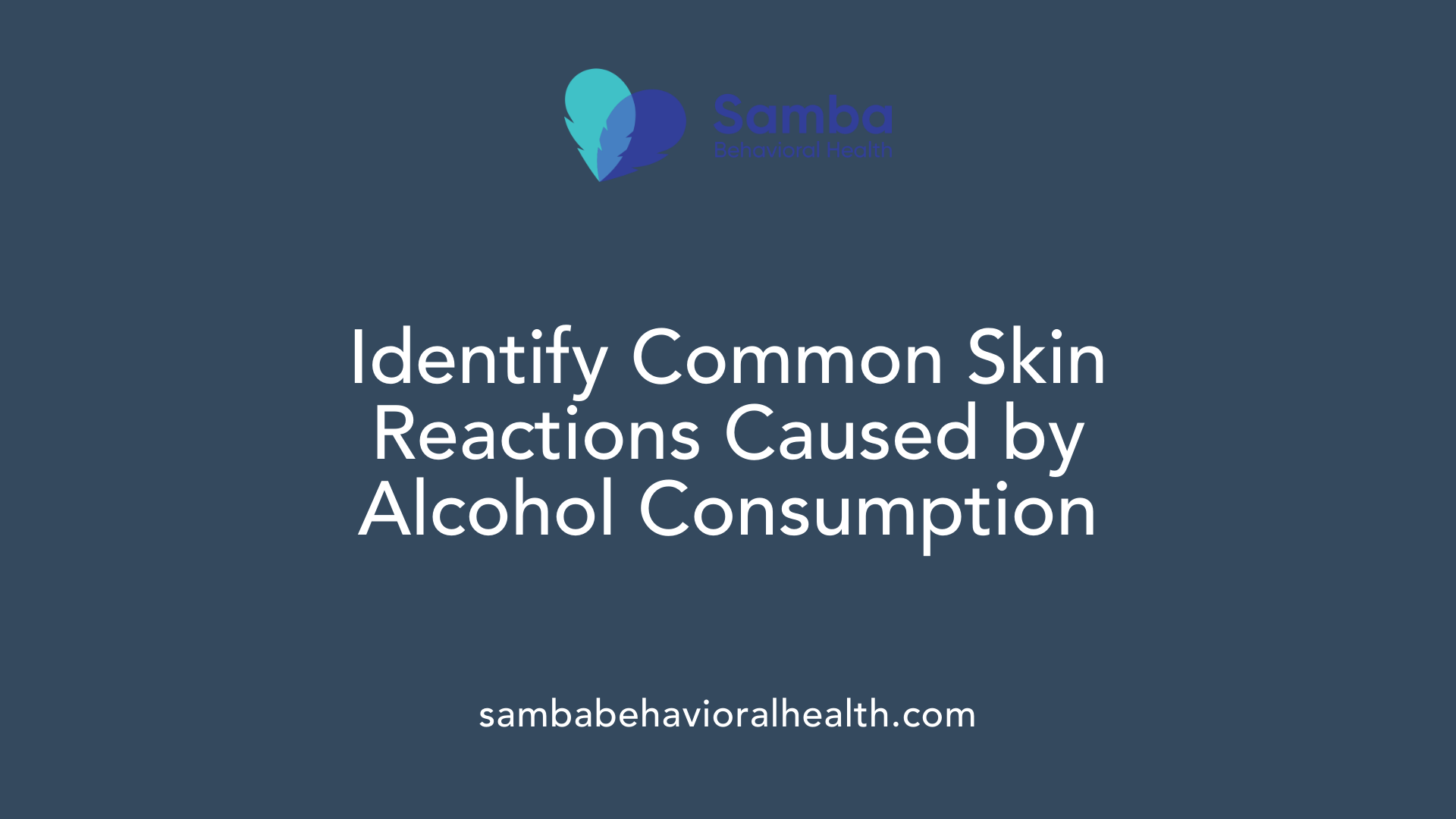
What are the common skin reactions associated with alcohol consumption?
Alcohol consumption can lead to a variety of skin reactions, some of which are mild and temporary, while others may be more serious. The most common reactions include flushing, redness, rashes, and itching. These symptoms often arise from allergic responses, intolerances, or side effects related to genetic factors.
A well-known reaction is facial flushing and redness, especially in people of East Asian descent, caused by a genetic deficiency in the enzyme aldehyde dehydrogenase (ALDH2). This deficiency results in the buildup of acetaldehyde, a compound that dilates blood vessels and causes a visible redness.
Many skin reactions are triggered by irritants or impurities in alcohol, such as sulfites in wine or gluten in beer. Additionally, alcohol can exacerbate existing skin conditions like rosacea and psoriasis, leading to more pronounced redness and inflammation.
Alcohol can also induce or worsen sun sensitivity, increasing the risk of sunburns, blisters, and skin damage. In some cases, it can weaken the skin's immune defense, making it more susceptible to infections such as cellulitis.
Severe allergic reactions, although rare, may include swelling of the face, tongue, or throat, which require urgent medical intervention. They can also cause hives—red, itchy bumps that appear suddenly after drinking.
Chronic heavy drinking is linked to nutritional deficiencies, notably vitamin C deficiency or scurvy, which manifests as perifollicular petechiae and ecchymoses. These are hemorrhagic skin signs caused by compromised blood vessel integrity due to inadequate collagen synthesis.
In addition, long-term alcohol use might lead to skin conditions like seborrheic dermatitis, characterized by greasy, itchy patches, and an increased risk of skin cancers. Alcohol also diminishes the body's ability to repair DNA, further elevating cancer risks.
Overall, while most alcohol-related skin reactions are harmless and resolve with alcohol clearance, severe reactions and complications like infections or nutritional deficiencies require medical attention. Preventive measures involve moderating or avoiding alcohol, especially for those with known sensitivities or existing skin conditions.
Signs and Symptoms of Alcohol-Related Skin Reactions
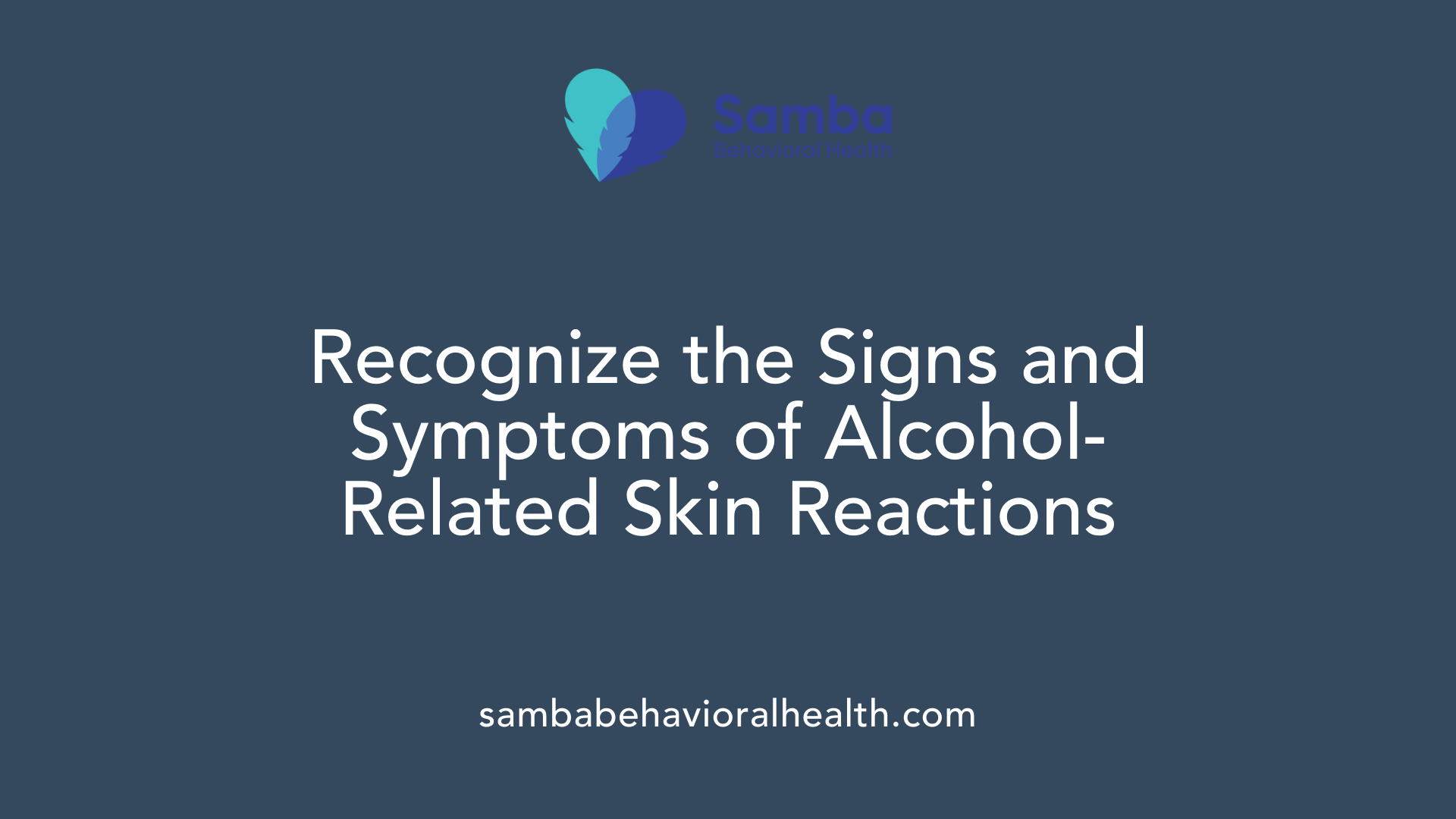
What are symptoms and signs of skin reactions related to alcohol use?
Alcohol-related skin reactions often manifest through a variety of visible and physical signs. One of the most common early indicators is facial flushing and redness, especially around the cheeks, neck, and chest. This occurs due to blood vessel dilation and the buildup of acetaldehyde in individuals with alcohol intolerance, a genetic condition more prevalent in East Asian populations.
In addition to flushing, many people experience hives, which appear as red, itchy bumps on the skin. Burning sensations and itching are also frequently reported, signaling irritation or allergic responses to alcohol or its impurities.
Chronic alcohol consumption can lead to telangiectasia, also known as spider veins, which are dilated small blood vessels visible just beneath the skin. These vascular changes are often associated with liver damage or prolonged vascular dilation.
Long-term effects include more severe skin and liver signs such as jaundice (yellowing of the skin and eyes), palmar erythema (redness of the palms), and the appearance of spider veins across the face and body. Alcohol can cause skin dehydration, leading to dry, flaky skin, increased puffiness, and accentuated wrinkles, especially in aging drinkers.
People with existing skin conditions like rosacea or psoriasis may find these conditions worsened by alcohol intake, with increased redness and flare-ups.
In some cases, alcohol triggers allergic-like reactions, with swelling of the face, lips, or throat, and sensations of burning or itching.
Overall, signs of alcohol-related skin reactions encompass both immediate and long-term changes, reflecting the impact of alcohol on blood vessels, immune response, and skin health.
Can Alcohol Cause Allergic Skin Rashes?
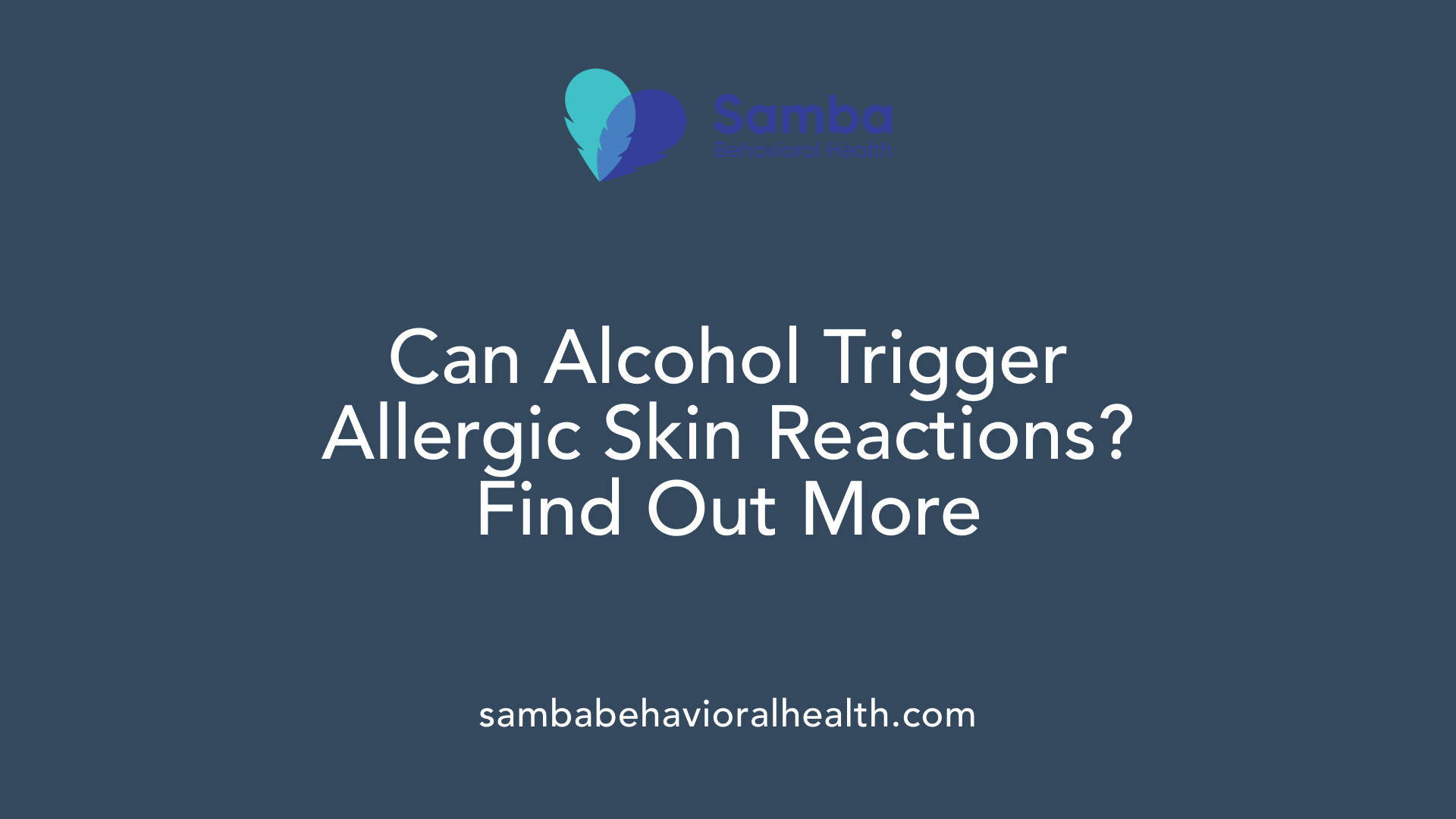
What is the difference between allergy and intolerance?
Alcohol-related skin reactions can stem from either an allergic response or an intolerance. An allergy involves the immune system attacking substances in alcohol or its ingredients, leading to symptoms such as hives, rashes, swelling, or difficulty breathing. These reactions tend to be sudden and severe. In contrast, alcohol intolerance is a metabolic issue, often due to enzyme deficiencies like ALDH2, resulting in symptoms such as facial flushing, nausea, and rapid heartbeat. Understanding the difference is crucial for proper management and avoiding unnecessary risks.
How is diagnosis and testing for alcohol-related skin reactions performed?
Diagnosing alcohol allergies or intolerances typically involves a medical examination and specific tests. Skin prick tests or blood tests can identify sensitivities to alcohol components like sulfites, histamines, or grains. For alcohol intolerance, especially related to ALDH2 deficiency common in East Asian populations, doctors may use ethanol patch tests or review personal and family history of reactions. Accurate diagnosis helps tailor treatment strategies and prevent future reactions.
What are the treatment options?
Treatment primarily involves avoiding alcohol and its triggering ingredients, such as sulfites, histamines, or grains. Mild allergic reactions may be managed with antihistamines to alleviate symptoms like rashes, itching, and swelling. In cases of severe reactions, such as anaphylaxis, immediate injection of epinephrine and emergency medical care are essential. Patients with diagnosed allergies should carry an epinephrine auto-injector and consult allergists or immunologists for personalized advice.
How can reactions be prevented?
Prevention revolves around awareness and lifestyle adjustments. The most effective strategy is to abstain from alcohol and products containing known triggers. Reading labels carefully to avoid sulfites, preservatives, and grains can reduce the risk of skin reactions. Choosing alcohol-free alternatives and staying vigilant about ingredient listing helps prevent accidental exposure. Educating oneself about genetic predispositions, such as the East Asian alcohol flush reaction, supports informed choices. Maintaining good hydration and managing stress also contribute to overall skin health and reduce susceptibility to reactions.
| Aspect | Details | Additional Information |
|---|---|---|
| Symptoms of reactions | Rash, hives, flushing, swelling, difficulty breathing | Vary from mild skin irritation to severe anaphylactic reactions |
| Common triggers | Alcohol, sulfites, histamines, grains, preservatives | Red wine, beer, spirits, and additives like dyes and stabilizers |
| Diagnostic methods | Skin prick tests, blood tests, ethanol patch testing | Specific for allergies or enzyme deficiencies |
| Management strategies | Avoidance, antihistamines, emergency treatment | Tailored to severity and individual sensitivity |
| At-risk populations | East Asian descent, those with existing allergies or sensitivities | Includes individuals with genetic enzyme deficiencies |
Duration of Alcohol-Related Skin Rashes
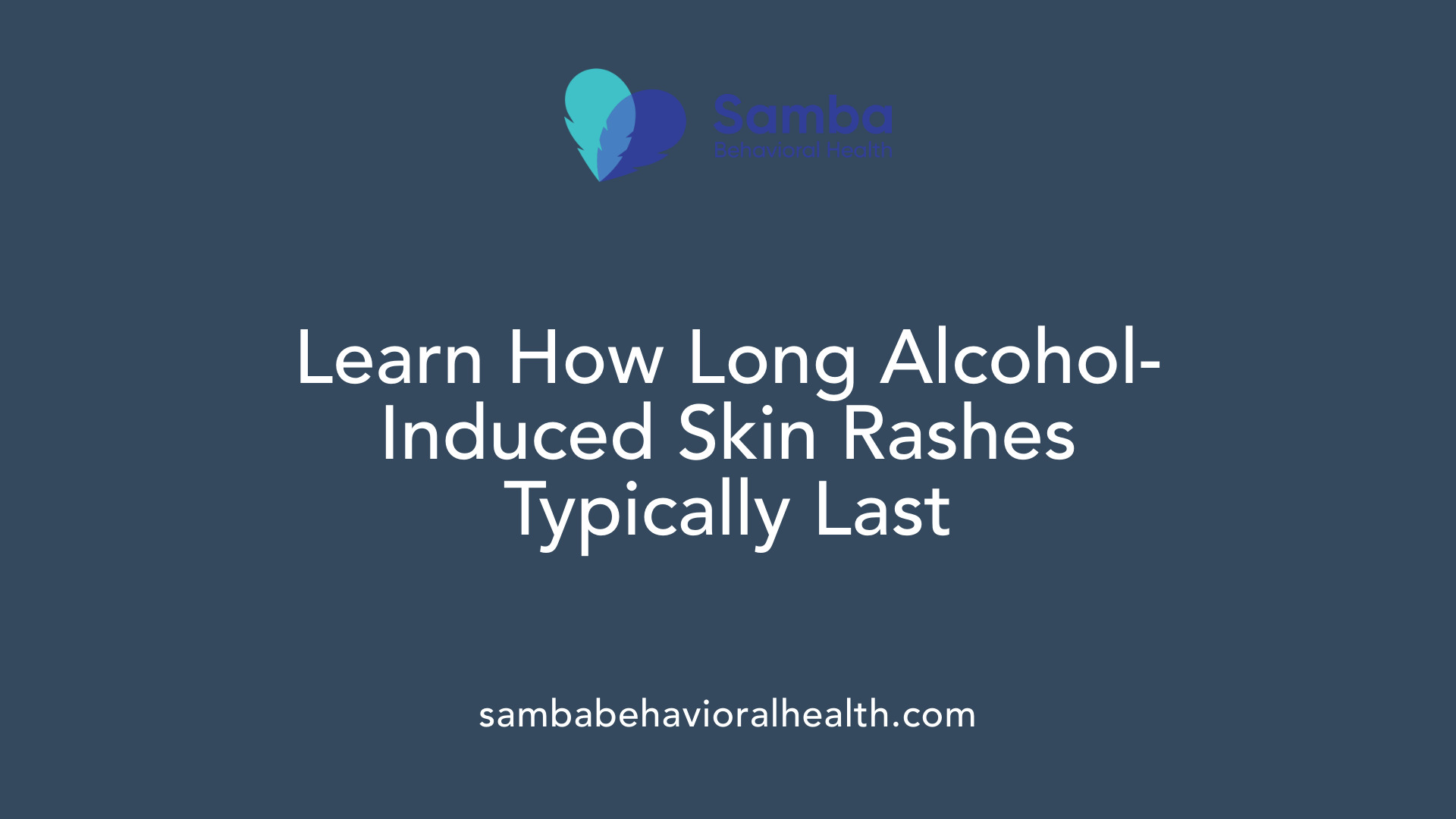
How long do alcohol-related skin rashes typically last?
Most skin reactions triggered by alcohol, such as hives or urticaria, are transient and tend to resolve quickly. Generally, these rashes can last from a few minutes up to about 10 minutes. They often improve or disappear entirely shortly after stopping alcohol consumption or administering antihistamines, which help counteract the allergic or immune response.
The length of these reactions can vary based on individual sensitivity and the underlying cause. For example, if the skin reaction is due to an allergic component or sensitivity to ingredients like sulfites or histamines present in certain drinks, it may last until the alcohol and allergenic substances are metabolized and eliminated.
In some cases, if the person continues to consume alcohol, the rash may persist as long as alcohol remains in the system, but it usually does not extend beyond half an hour. Severity and individual differences also influence duration: some people may experience short, fleeting reactions; others may have slightly longer episodes, especially if the reaction is part of a more complex allergy or enzyme deficiency.
Overall, alcohol-related skin rashes are typically brief episodes rather than long-lasting conditions. Recognizing this quick onset and resolution pattern helps in diagnosing and managing alcohol-induced skin reactions effectively.
Understanding Genetic and Environmental Factors in Alcohol Flushing and Rashes
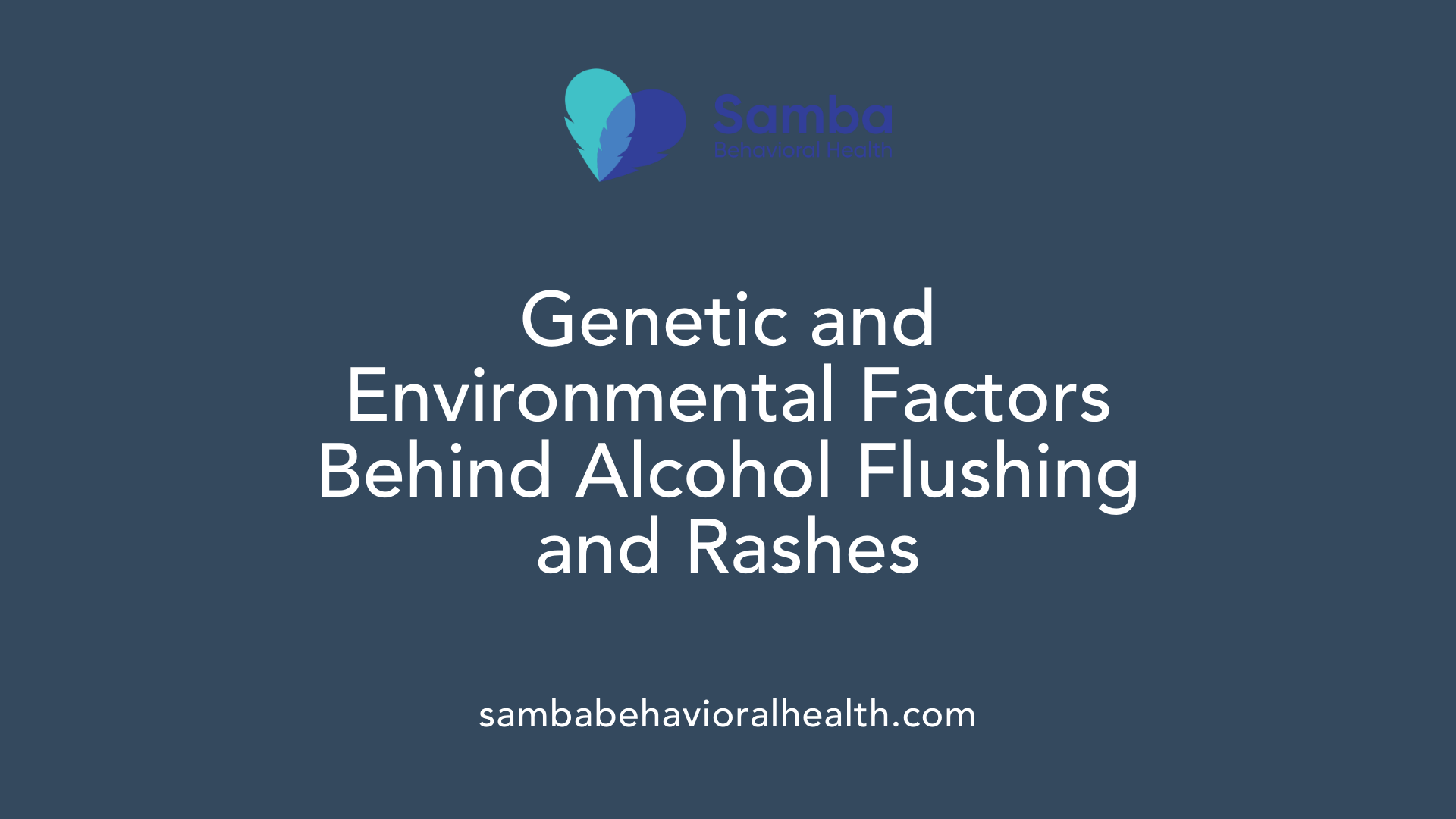
What role do genetics play in alcohol-induced skin reactions?
Genetics play a crucial role in how individuals react to alcohol, especially concerning skin reactions like flushing and rashes. A common genetic variation affects the enzyme aldehyde dehydrogenase 2 (ALDH2), which is vital in alcohol metabolism.
People of East Asian descent often carry a mutation that results in reduced ALDH2 activity. This mutation causes a slower breakdown of acetaldehyde, a toxic compound produced when alcohol is metabolized. As a result, acetaldehyde accumulates in the blood, leading to symptoms such as facial redness, warmth, and skin flushing. These reactions are not allergies but are due to the body’s inability to clear acetaldehyde efficiently.
Beyond ALDH2, genetic factors can influence individual sensitivity to histamines and impurities found in alcoholic drinks. Elevated histamine levels, common in certain wines and beers, can trigger skin reactions like hives and flushing, especially in sensitive individuals. Additionally, genetic predispositions can make some more prone to reactions triggered by preservatives or chemical additives in alcohol.
Understanding these genetic influences helps explain why some people experience significant skin reactions despite not having allergies. It also highlights the importance of recognizing personal sensitivities and choosing alcoholic beverages carefully to reduce adverse skin effects.
Treatment and Prevention of Alcohol-Related Skin Reactions
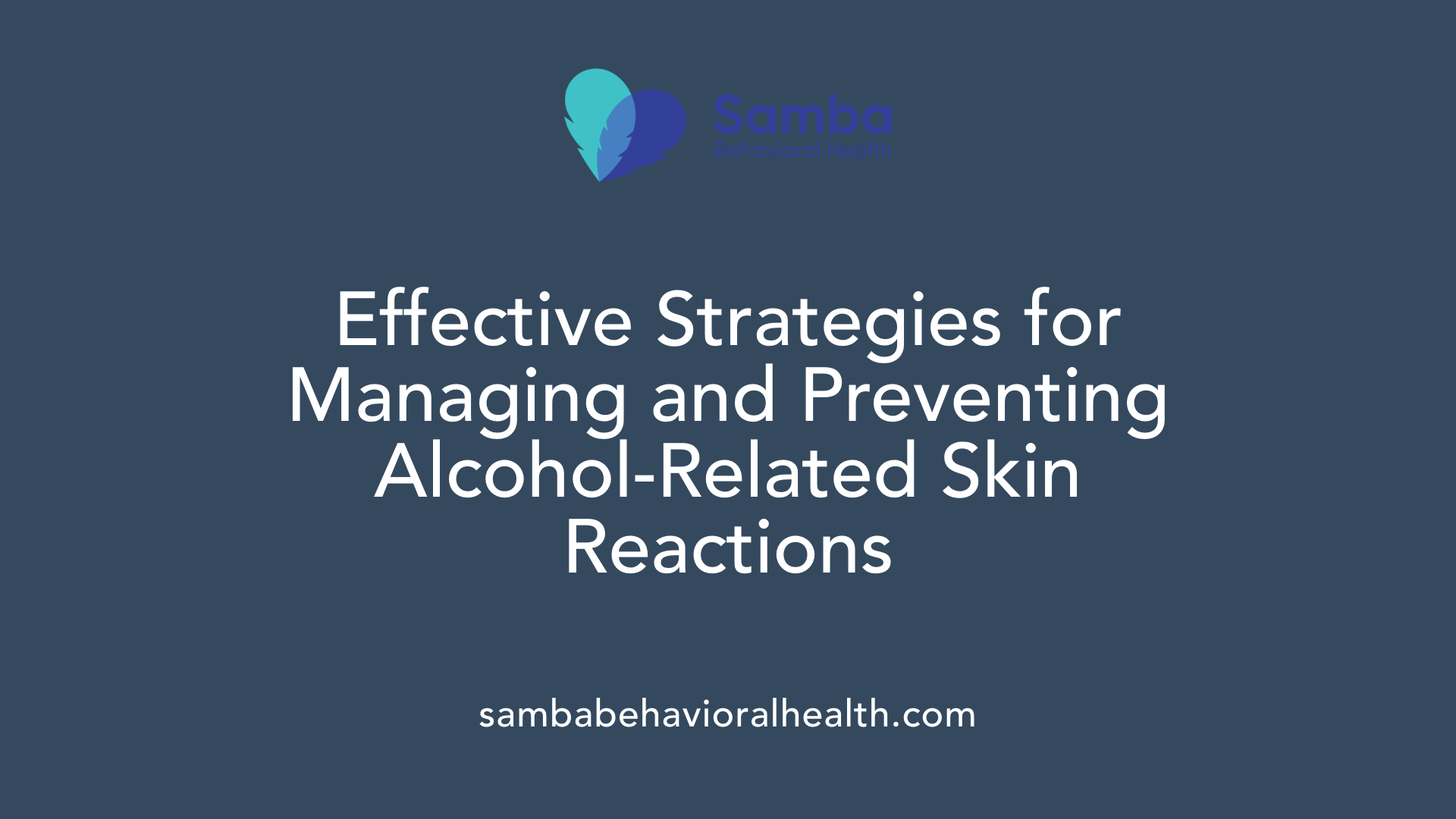
How is alcohol-related skin reactivity managed and prevented?
Managing skin reactions caused by alcohol involves a combination of lifestyle changes and medical interventions. The first step is avoiding alcohol altogether or limiting its consumption, especially beverages that contain certain additives like sulfites, histamines, or grains that may trigger reactions.
People with alcohol intolerance or allergies should abstain from drinking alcohol to prevent symptoms such as flushing, hives, or swelling. It’s also helpful to read labels carefully and choose drinks with fewer additives.
For mild symptoms like hives or redness, antihistamines can help reduce itching and swelling. Topical treatments, including moisturizers and corticosteroids, can soothe skin irritation.
In case of severe reactions, such as swelling of the face, tongue, or difficulty breathing, emergency treatment with epinephrine is vital. Such situations require immediate medical attention.
Education about ingredient sensitivities is crucial. Learning which components in alcoholic beverages trigger reactions allows individuals to avoid problematic drinks.
Support from healthcare professionals can help develop personalized management plans. These may include allergy testing, nutritional counseling, and guidance on safe drinking habits.
Overall, avoiding triggers, managing symptoms through medications, and being informed about individual sensitivities are effective strategies to prevent and control alcohol-related skin issues.
| Approach | Description | Additional Details |
|---|---|---|
| Lifestyle modifications | Abstaining or limiting alcohol intake, avoiding known triggers | Important for long-term skin health and reaction prevention |
| Medical treatments | Use of antihistamines, topical steroids, emergency epinephrine if needed | Tailored based on severity and type of reaction |
| Avoiding triggers | Reading labels, avoiding additives like sulfites and histamines | Reduces risk of immediate and delayed skin reactions |
| Managing symptoms | Symptomatic relief using medications and skin care products | Ensures comfort and reduces skin irritation |
By combining these strategies, individuals can better manage and prevent alcohol-related skin reactions, maintaining healthier skin and reducing discomfort.
Long-Term Effects of Chronic Alcohol Use on Skin and Overall Health
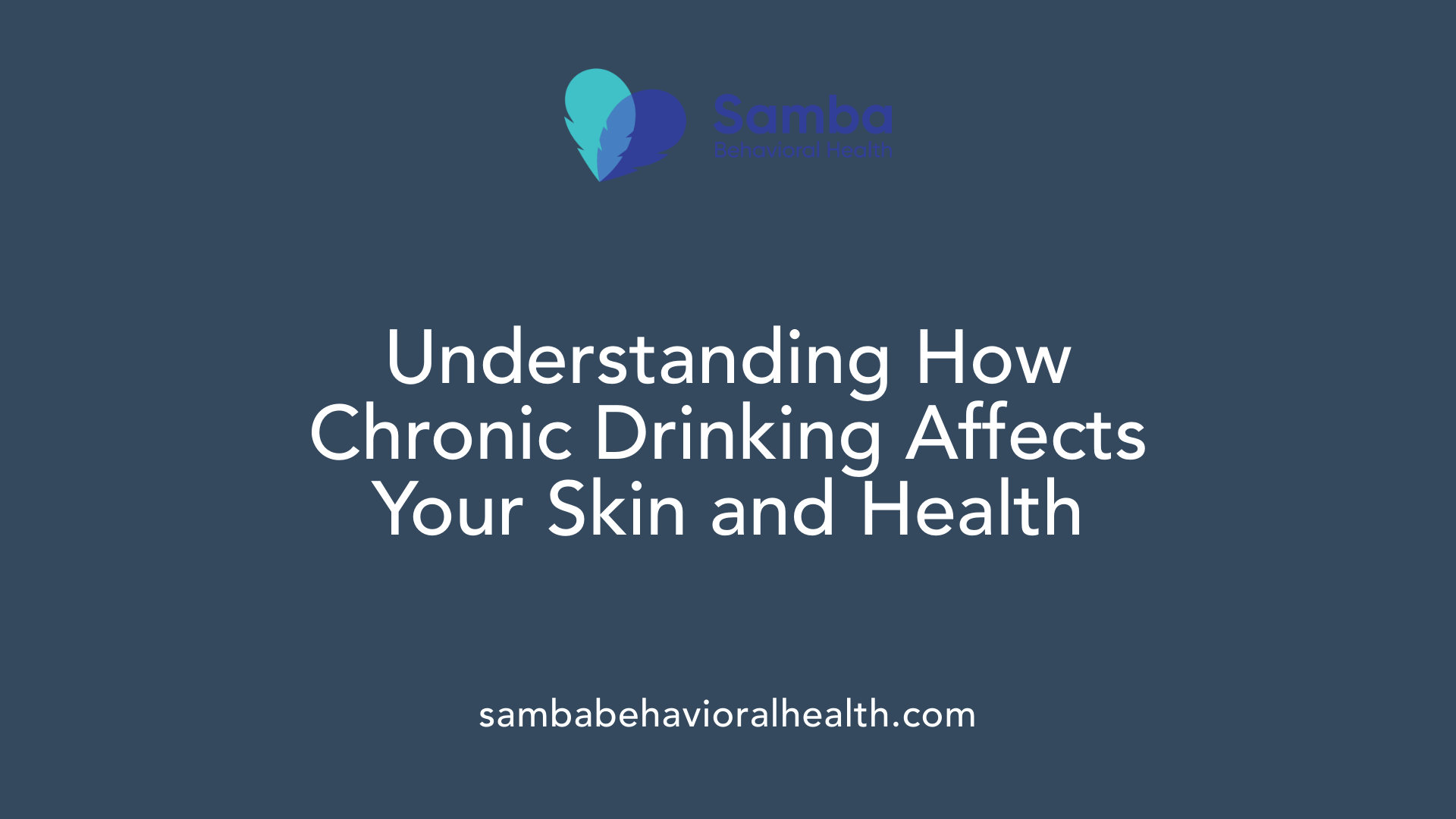
What are the long-term effects of chronic alcohol use on skin and health?
Long-term alcohol consumption can significantly impact both the skin and overall wellbeing. One of the most visible effects is liver damage, which often leads to jaundice—the yellowing of the skin and eyes, along with symptoms like spider telangiectasia (spider veins) and palmar erythema (redness of palms). These signs reflect the liver’s impaired ability to detoxify the body.
Chronic drinking also accelerates skin aging. This manifests as increased wrinkles, a sunken appearance, hyperpigmentation, dryness, and a rough texture. Alcohol’s dehydrating effect reduces skin elasticity and hampers collagen production, making the skin more prone to sagging and age spots.
A heightened risk of skin cancers, including melanoma, basal cell carcinoma, and squamous cell carcinoma, has been linked to prolonged alcohol use. Alcohol impairs DNA repair mechanisms after sun damage and suppresses immune function, increasing vulnerability to various skin malignancies.
In addition to skin-related issues, long-term alcohol abuse can cause systemic health problems. It raises the risk of bacterial and fungal infections, worsens pre-existing skin conditions like psoriasis, and can lead to nutritional deficiencies affecting vital nutrients like vitamins A, B, and C. These deficiencies contribute to more skin problems, such as dryness, poor wound healing, and increased susceptibility to infections.
Beyond the skin, chronic alcohol consumption affects other organs and systems. It increases the risk of cardiovascular disease, impairs immune responses, and damages organs like the pancreas and brain. Overall, alcohol’s long-term effects are extensive and can severely diminish quality of life, emphasizing the importance of moderation and medical intervention when necessary.
Maintaining Skin Health in the Context of Alcohol Use
Understanding how alcohol influences skin health is essential for making informed choices. While moderate alcohol consumption may cause temporary skin reactions such as flushing and redness, heavy or chronic use can lead to significant skin damage, nutritional deficiencies, and increased risk of various skin conditions and cancers. Recognizing the signs of alcohol-related skin issues and seeking medical advice are crucial steps in prevention and management. Abstaining from alcohol or reducing intake, especially for individuals predisposed to skin sensitivities, can help protect skin health and overall well-being. Ultimately, moderation and awareness are key to minimizing alcohol's impact on your skin.
References
- Does Alcohol Cause Rashes? - The Recovery Village
- How Drinking Alcohol Affects Your Skin - WebMD
- A Reversible Cause of Cutaneous Rash in a Patient With Alcohol ...
- Alcohol intolerance - Symptoms & causes - Mayo Clinic
- What is an Alcoholic Rash? - Sabino Recovery
- Alcohol and the Skin - DermNet
- Does Alcohol Cause Skin Rashes? - Action Rehab
- Alcohol Intolerance: Symptoms, Tests & Alcohol Allergy
